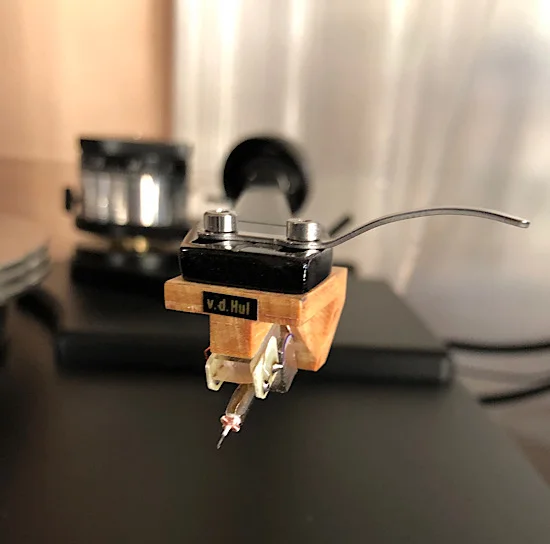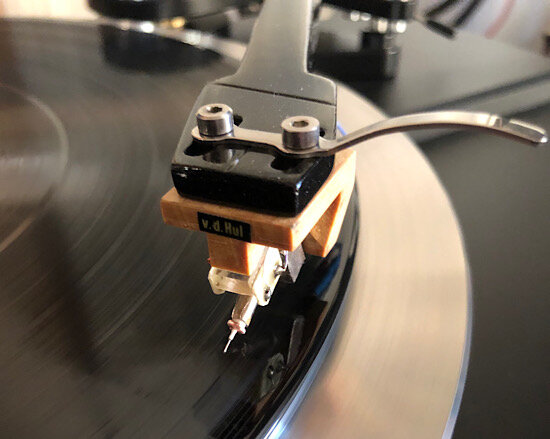van den Hul Colibri Master Signature Moving Coil Phono Cartridge
van den Hul is a Dutch company, created in 1980 by renown A.J. (Aalt Jouk) van den Hul (VDH) that designs and manufactures high-end moving coil phono cartridges, audio cables and other audio electronics. (Bowers & Wilkins, for example, among others, are known to use van den Hul internal wiring in their speakers.)
On an early Autumn phone call from Mat Weisfeld, President of VPI Industries, I was informed that VPI had become the sole USA distributor for their phono cartridges and I was offered a chance to review van den Hul’s newest top-of-the-line moving coil cartridge: the Colibri Master Signature, entirely hand made and tuned by A.J.—now in his 80s—and with a retail price of $11,995. Now that I use a VPI Industries HW-40 Direct Drive turntable as reference, I thought this may be an intriguing match. Besides, it uses a high-density wood for its enclosure, and I happen to be a fan of that (my current reference cart is the Grado Labs Aeon). Last, but not least, I was attracted to the simple van den Hul philosophy of cart design in which they claim to provide ‘The link between technique and emotion’:
Our main objective is to improve the quality of both phono transfer and the quality of signal transmission in the most broad sense. We do this by applying unique solutions and state-of-the-art technology based on our own inventions, findings and listening experience.
van den Hul names many of its cartridges after birds (Colibri, Crimson, Condor, Canary), but there is also a Frog series and the Grasshopper, as well as some other classic models.
The Colibri Master Signature is a re-designed variation of the previous Colibri. It is newer than the Colibri XGW Signature Stradivarius, and its specs (listed below) are significantly different to that in weight, output voltage and channel separation dB, as examples. Because this cart is hand made by A.J., and he personally signs each box that the cart comes in and writes the specs on it, too, there is slight variation between each one; it might require personal attention. This is not a cart that is on automatic pilot; you must be prepared to pay close attention to details and set up, and be willing to do some experimentation to determine the optimal settings for your own system. This is a bespoke, artisanal cartridge.
At $11,995, however, one of the first concerns I confronted in addition to the high price was the lack of any cover to protect the stylus when not in use or when mounting; the longer than usual stylus/cantilever extends well out beyond the front of the body, about 0.5 cm so, and is entirely exposed.
Thankfully, the Weisfelds came to the rescue in the initial mounting (Mat and his father Harry, the founder of VPI) : Harry kindly and ever so carefully mounted the cart at the VPI house, and then several weeks later Mat came to my apartment to make sure all was well by helping do some further experiments and then re-mounting the cart. I often experimented with VTA adjustments (so easy to do with the HW-40). As I discovered quickly, this cart’s performance is very sensitive to VTA; too much one way and the sound can become edgy and bright—ouch. Obsessed audiophiles with patience and motivation may consider adjusting the VTA based on the album under consideration.
Looks and setup
The cart is small, relatively light (8.75 grams) but heavier than its predecessor (6.0 gm), and with a tracking force of only 1.35–1.50 gm the lightest I have ever dealt with. I kept it at about 1.5 gm after experimentation. Its innards are essentially open to the naked eye; there is no full cover/shell per se—the wooden enclosure is a half shell that covers just the top and back of the unit. The wood used is a high density, yellowish in color, Brazilian Pau Amarello (Yellowheart). It is not flashy, fashionable or artistic looking; simplicity governs the design.
I used as reference equipment, a Pass Labs XP-17 phono stage set at 300 Ohms load impedance, and 56 dB gain followed by a PS Audio BHK Signature preamplifier, and a pair of Audio by Van Alstine DVA SET 600 mono block amps. For speakers I used a pair of Alta Audio FRM-2 Celesta (the new upgraded model) and a pair of the new Alta Audio Alec.
Sound
I would describe the overall sound signature of the Master Signature as austere (by which I mean, transparent, simple without ornament, and a bit stern) and very detailed with remarkably low surface noise, and an unusually spacious sound stage—if you often listen to symphonies this just might be for you. The sound is a dash lean (mostly at the higher frequency range), not of the warm and full type. If there is vocal sibilance to be found somewhere in a pressing, the Master Signature will find it with ease—listener beware.
Its retrieval of low level information is astonishing and it is so very fast. Often I sensed in recordings that I was hearing tiny things like a moving chair, a cough, or someone walking with delicate reverbations; subtleties I had not noticed before. In fact I would go as far as saying that it is the most detail-oriented cart I have ever heard. It is painfully unforgiving with bad recordings, but sensitive and merciful with great ones— sometimes gloriously so, such as with Moussorgsky, Pictures at an Exhibition, Chicago Symphony Orchestra, Fritz Reiner, (1957), RCA Victor Red Seal. The build up and sustainment of the snare drum rolls and timpani with its lingering presence, for example, is out of this world.
If you want to get further gist of the Master Signature’s strengths: (for better or for worse) check out the original 1960s 4 LP pressing of Johannes Brahms, The Four Symphonies, with Karajan/Berlin Phil on Deutsche Grammophon (not the new 2017 reissue that paid attention). I stumbled upon it several months ago in nearly perfect condition buried in a box that a friend gave me. On full display with the Master Signature you get both the extraordinary performance on the one hand, but the overall relatively bad recording quality on the other. I particularly do not like the way percussion is recorded there. As an amateur drummer from years ago, the timpani are way out of focus both in spacial depth and in sound quality. Audiophilia’s Publisher described the recording quality as a ‘soupy, congealed mess’. You will get all and more of this with the Master Signature.
Specifications
Matched crystal gold wire coils
40dB channel separation
Tracking Force between 1.35 - 1.50 grams
Anti-skating Force between 0.0 - .6 grams
Effective Arm Mass of 1.0 - 1.6 grams
Load Impedance: 50 ohms to 47K ohms
Optimal Loading: 50 ohms to 600 ohms
Output Level 1.1mV/channel
Weight: 8.75gm
Summary
Although very expensive, the VDH Colibri Master Signature is a rare and unique cartridge, with an attention to detail that is nothing short of astonishing. Although it may require some delicate VTA modification at times, the reward outweighs the investment: one of the very finest carts out there that I’ve had the pleasure of hearing and experimenting. If you can at least get to hear it somewhere, do so; and perhaps choose classical music to go with it.
Further information: van den Hul; USA Distributor






